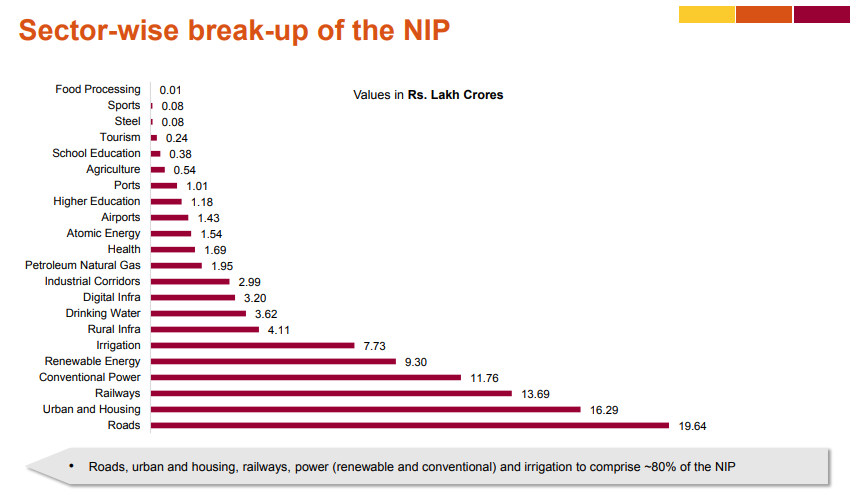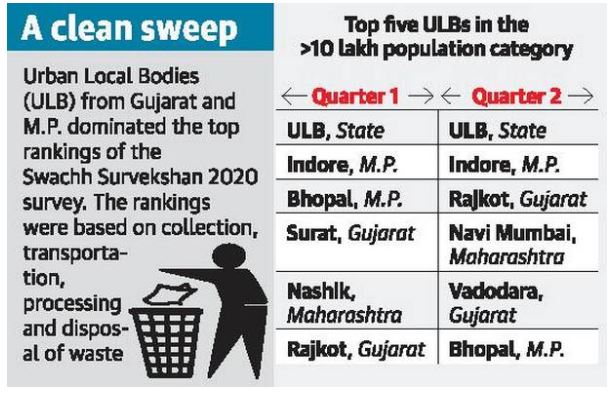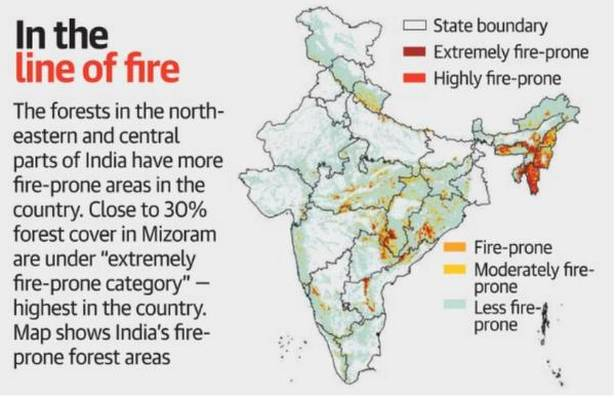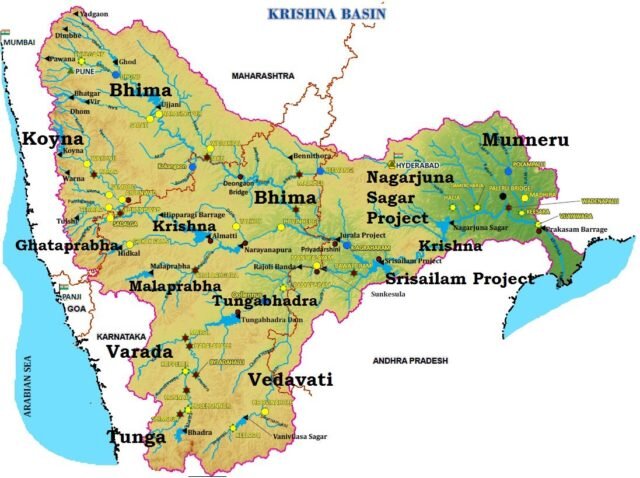Indian Economy
National Infrastructure Pipeline
Why in News
Recently, the Government has released a report of the task force on National Infrastructure Pipeline for 2019-2025.
- Earlier, the Prime Minister in his Independence Day speech 2019 had highlighted that ₹100 lakh crore would be invested on infrastructure over the next 5 years.
- The emphasis would be on ease of living: safe drinking water, access to clean and affordable energy, healthcare for all, modern railway stations, airports, bus terminals and world-class educational institutes.
- Task Force was constituted to draw up the National Infrastructure Pipeline (NIP) for each of the years from financial years 2019-20 to 2024-25.
National Infrastructure Pipeline
- NIP will enable a forward outlook on infrastructure projects which will create jobs, improve ease of living, and provide equitable access to infrastructure for all, thereby making growth more inclusive.
- NIP includes economic and social infrastructure projects.
- During the fiscals 2020 to 2025, sectors such as Energy (24%), Roads (19%), Urban (16%), and Railways (13%) amount to around 70% of the projected capital expenditure in infrastructure in India.
- It has outlined plans to invest more than ₹102 lakh crore on infrastructure projects by 2024-25, with the Centre, States and the private sector to share the capital expenditure in a 39:39:22 formula.
Governance
Swachh Survekshan 2020
Why in News
The Ministry of Housing and Urban Affairs (MoHUA) has announced the results of the first (April-June) and second (July- September) quarters of Swachh Survekshan 2020.
- Swachh Survekshan 2020 is the 5th edition of the annual urban cleanliness survey conducted by the Ministry.
Format/ Method of Assessment
- Swachh Survekshan 2020 is evaluated for each quarter on the basis of monthly updation of Swachh Bharat Mission-Urban (SBM-U) online Management Information System (MIS) by cities along with citizen’s validation on the 12 service level progress indicators.
- Swachh Survekshan 2020 has been conducted in 3 quarters:
- April – June
- July – September
- October – December 2019
- These quarterly assessments will hold 25% weightage in the annual survey which is scheduled to commence from 4th January 2020 across India.
- Ranks for Swachh Survekshan 2020 have been assigned based on the population in two categories of the cities :
- 1 lakh and above with sub-categories of
- 1-10 lakh
- 10 lakhs and above.
- Less than 1 lakh (under this category, the rankings are given zone and population-wise).
- It includes five zones namely, North, East, Northeast, South and West.
- 1 lakh and above with sub-categories of
Key Points
- Indore (Madhya Pradesh) and Jamshedpur (Jharkhand) have topped the cleanliness charts for two consecutive quarters among cities with over 10 lakh population and with 1 lakh to 10 lakh population respectively.
- Kolkata ranked at the bottom of the ranking of 49 major cities across both quarters as West Bengal did not participate in the nationwide exercise.
- Among cantonment boards, Tamil Nadu's St.Thomas Mount Cantt was ranked 1st in quarter 1 whereas Delhi Cantt ranked first in the 2nd quarter.
- Secunderabad Cantonment Board in Hyderabad is the worst performer among other cantonment boards.
Biodiversity & Environment
One-fifth of the Country’s Forests Prone to Fire
Why in News
Recently, the 2019 report by Forest Survey of India (FSI) was released. It states that about 21.40% of forest cover in India is prone to fires, with forests in the north-eastern region and central India being the most vulnerable.
- FSI carried out a study along forest fire points (FFP) identified across the country from 2004 to 2017.
- There are total 2,77,758 FFP identified during the 13 years.
- FFPs were analysed using a moderate resolution imaging spectroradiometer (MODIS) by overlaying the points coverage over the grid coverage of 5 km x 5 km.
Forest Survey of India
It is a premier national organization under the Union Ministry of Environment and Forests responsible for assessment and monitoring of the forest resources of the country regularly.
Key Points
- Extremely fire-prone areas account for 3.89% of total forest cover, very highly fire-prone areas account for 6.01% and highly fire-prone areas for 11.50%. Together, the three categories come to 21.40 % of forest cover.
- From November 2018 to June 2019, there were total 29,547 alerts based on MODIS. Mizoram recorded the highest number of fire alerts (2,795).
- The north-eastern region accounted for about one-third of alerts in the country.
- The Central Indian States also recorded a high number of forest fire alerts.
- Alerts: Madhya Pradesh > Maharashtra > Odisha > Chhattisgarh
- The overall green cover has increased in the country but the forest cover in the north-east, particularly in Mizoram, Arunachal Pradesh and Nagaland, has decreased.
- The uncontrolled forest fires can lead to significant loss of forest cover. Climate change influences the frequency and intensity of forest fires and results in forests becoming increasingly inflammable.
- Reasons for Forest Fires
- Thunderstorms are the most likely natural cause for forest fires.
- In central India, the reasons are mainly manmade, particularly in cases where people visit forests and leave burning bidis, cigarette stubs or other inflammable materials.
- A major reason for forest fires in the north-east is slash-and-burn cultivation, commonly called jhoom or jhum cultivation.
- The north-east has tropical evergreen forests which are not likely to catch fire easily on their own like the dry deciduous forests of central India.
Social Justice
SC Bats Against the Transfer of Community Resources
Why in News
Recently, the Supreme Court of India held that the Government has no right to transfer “invaluable” community resources like village water ponds to powerful people and industrialists for commercialisation of the property.
- It is necessary to protect village commons for safeguarding the fundamental right guaranteed by Article 21 of our Constitution. These common areas like water ponds and wells are the lifeline of village communities and often sustain various chores and provide resources necessary for life.
- Article 21: Protection of life and personal liberty. No person shall be deprived of his life or personal liberty except according to the procedure established by law.
- It is fundamental, non-derogable and is available to every person. Even the State cannot violate that right.
Key Points
- The judgment came on a plea against the transfer of village ponds’ sites of Saini village in the National Capital Region to some private industrialists by the Greater Noida Industrial Development Authority.
- The National Green Tribunal (NGT) refused to intervene on the plea but the apex court ordered the authorities and the industrialists to remove all obstructions and restore the water bodies within three months.
- SC said the State can not deprive the villagers of their existing source of water and other community resources even after the promise of providing them with an alternative source. There is no guarantee that the adverse effect of destroying the existing water body would be offset and people would be compelled to travel miles to access the alternative site.
- Resources which are available for everyone’s use in a community, village or town are called community resources. For example- ponds, playgrounds, public parks etc.
Important Facts For Prelims
202nd Anniversary of the Bhima-Koregaon Battle
Why in News
The victory pillar (also known as Ransthamb) in Bhima-Koregaon village (Pune district of Maharashtra) is to celebrate the 202nd anniversary of the Bhima-Koregaon battle of 1818 on January 1, 2020.
- In 2018, incidents of violence were registered during the celebration of the 200th anniversary of the Bhima-Koregaon battle.
Historical Background
- A battle was fought in Bhima Koregaon between the Peshwa forces and the British on January 1, 1818.
- The British army, which comprised mainly of Dalit soldiers, fought the upper caste-dominated Peshwa army. The British troops defeated the Peshwa army.
- Peshwa Bajirao II had insulted the Mahar community and terminated them from the service of his army. This caused them to side with the English against the Peshwa’s numerically superior army.
- The defeat of Peshwa army was considered to be a victory against caste-based discrimination and oppression.
- It was one of the last battles of the Third Anglo-Maratha War, which ended the Peshwa domination.
- Babasaheb Ambedkar’s visit to the site on January 1, 1927, revitalised the memory of the battle for the Dalit community, making it a rallying point and an assertion of pride.
Important Facts For Prelims
Tribes in Odisha
Why in News
The poor implementation of government welfare programmes in the tribal areas of Odisha is affecting the tribes like Juanga, Pudi Bhuyan.
Juanga Tribe
- Juangas are one of the 13 Particularly Vulnerable Tribal Groups (PVTG) out of the total 62 tribes found in Odisha.
- They speak Juanga, a dialect of Munda language.
- They usually observe their festivals and marriage ceremony with Changu dance.
- Early marriage is a common practice among Juangas, leading to complications among children born out of young parents.
Pudi Bhuyan Tribe
- Pudi Bhuyan is a major section of the historically famous Bhuinya tribe.
- This tribe is majorly found in Bihar, Odisha, West Bengal and Assam.
- It is one of the 13 Particularly Vulnerable Tribal Groups (PVTG) in Odisha.
- They speak local Odia language which is pronounced differently.
Important Facts For Prelims
Ghataprabha River
It is a tributary of Krishna that flows in Karnataka. Ghataprabha has a hydroelectric and irrigational dam at Hidkal.
- Hidkal Dam is located in Belagavi district in Karnataka. The dam was completed in 1977. To make it multipurpose project a reservoir was also constructed on the dam.
- Tributaries of Ghataprabha: Hiranyakeshi and Markandeya rivers.
- Krishna is the second largest river in peninsular India. It rises in the Western Ghats at an altitude of 1337m. near Mahabaleshwar in Maharashtra.
- Krishna flows through Maharashtra, Karnataka, Telangana and Andhra Pradesh and finally drains into the Bay of Bengal.








